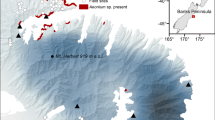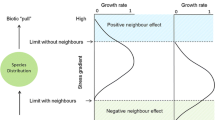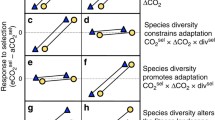Abstract
Understanding the factors that limit species distributions has become increasingly important in the face of rapid climate change. Many approaches have been used to predict responses of species and communities to new environmental challenges, including species distribution modelling, glasshouse and growth cabinet experiments, and small-scale field manipulations, all of which have both advantages and limitations. Here, we review the use of a powerful, direct method to predict how species and communities will respond to the changing climate: the field transplant experiment. We discuss how transplant experiments can elucidate the factors that limit species distributions; disentangle the role of genetic change vs. phenotypic plasticity in species’ responses; and improve understanding of the role of species interactions in driving community change. Several generalisations about potential species’ responses to climate change are emerging from these studies, including the critical role of specific life stages in response to warming trends, the role of natural enemies and new hosts in limiting or promoting adaptive capacity, and the role of niche saturation in conferring community stability at a functional guild level. Transplant experiments have also confirmed likely mechanisms of recent range shifts and highlighted the potential for some modelling exercises to overestimate future range changes. With the prospect that accelerating warming over the next few decades will increase extinction rates and accelerate ecosystem degradation, we urge researchers to utilise this powerful but underused method more widely.

Similar content being viewed by others
References
Ågren J, Schemske DW (2012) Reciprocal transplants demonstrate strong adaptive differentiation of the model organism Arabidopsis thaliana in its native range. New Phytol 194:1112–1122
Alexander JM, Diez JM, Levine JM (2015) Novel competitors shape species’ responses to climate change. Nature 525:515–518
Allison SD, Lu Y, Weihe C, Goulden ML, Martiny AC, Treseder KK, Martiny JBH (2013) Microbial abundance and composition influence litter decomposition response to environmental change. Ecology 94:714–725
Andrew NR, Hughes L (2007) Potential host colonization by insect herbivores in a warmer climate: a transplant experiment. Glob Chang Biol 13:1539–1549
Barton BT (2011) Local adaptation to temperature conserves top-down control in a grassland food web. Proceedings of the Royal Society B-Biological Sciences 278:3102–3107
Bennington CC, Fetcher N, Vavrek MC, Shaver GR, Cummings KJ, McGraw JB (2012) Home site advantage in two long-lived arctic plant species: results from two 30-year reciprocal transplant studies. J Ecol 100:841–851
Bimüller C, Dannenmann M, Tejedor J, von Lützow M, Buegger F, Meier R, Haug S, Schroll R, Kögel-Knabner I (2014) Prolonged summer droughts retard soil N processing and stabilization in organo-mineral fractions. Soil Biol Biochem 68:241–251
Boshier D, Broadhurst L, Cornelius J, Gallo L, Koskela J, Loo J, Petrokofsky G, St Clair B (2015) Is local best? Examining the evidence for local adaptation in trees and its scale. Environmental Evidence 4:20
Briones MJI, Ineson P, Piearce TG (1997) Effects of climate change on soil fauna; responses of enchytraeids, diptera larvae and tardigrades in a transplant experiment. Appl Soil Ecol 6:117–134
Bruelheide H (2003) Translocation of a montane meadow to simulate the potential impact of climate change. Appl Veg Sci 6:23–34
Buckley J, Bridle JR (2014) Loss of adaptive variation during evolutionary responses to climate change. Ecol Lett 17:1316–1325
Budge K, Leifeld J, Egli M, Fuhrer J (2011) Soil microbial communities in (sub)alpine grasslands indicate a moderate shift towards new environmental conditions 11 years after soil translocation. Soil Biol Biochem 43:1148–1154
Burger C, Nord A, Nilsson JA, Gilot-Fromont E, Both C (2013) Fitness consequences of northward dispersal as possible adaptation to climate change, using experimental translocation of a migratory passerine. PLoS One 8:e83176
Byars SG, Hoffmann AA (2009) Lack of strong local adaptation in the alpine forb Craspedia lamicola in Southeastern Australia. Int J Plant Sci 170:906–917
Byars SG, Papst W, Hoffmann AA (2007) Local adaptation and cogradient selection in the alpine plant, Poa hiemata, along a narrow altitudinal gradient. Evolution 61:2925–2941
Clausen J, Keck DD, Heisey WM (1948) Experimental studies on the nature of species. III. Environmental responses of climatic races of Achillea. Carnegie Institution, Washington D.C
Connell JH (1961) The influence of interspecific competition and other factors on the distribution of the barnacle Chthamalus stellatus. Ecology 42:710–723
Cotto O et al (2017) A dynamic eco-evolutionary model predicts slow response of alpine plants to climate warming. Nat Commun 8:15399
Crozier LG (2004) Warmer winters drive butterfly range expansion by increasing survivorship. Ecology 85:231–241
De Frenne P, Graae BJ, Brunet J, Shevtsova A, Schrijver AD, Chabrerie O, Cousins SAO, Decocq G, Diekmann M, Hermy M, Heinken T, Kolb A, Nilsson C, Stanton S, Verheyen K (2012) The response of forest plant regeneration to temperature variation along a latitudinal gradient. Ann Bot 109:1037–1046
De Frenne P, Graae BJ, Rodríguez-Sánchez F, Kolb A, Chabrerie O, Decocq G, De Kort H, De Schrijver A, Diekmann M, Eriksson O, Gruwez R, Hermy M, Lenoir J, Plue J, Coomes DA, Verheyen K (2013) Latitudinal gradients as natural laboratories to infer species’ responses to temperature. J Ecol 101:784–795
Etterson JR, Shaw RG (2001) Constraint to adaptive evolution in response to global warming. Science 294:151–154
Forrest JRK, Thomson JD (2011) An examination of synchrony between insect emergence and flowering in the Rocky Mountains. Ecol Monogr 81:469–491
Franklin J (2010) Mapping species distribution: spatial inference and prediction. Cambridge University Press, Cambridge
Frei ER, Ghazoul J, Matter P, Heggli M, Pluess AR (2014) Plant population differentiation and climate change: responses of grassland species along an elevational gradient. Glob Chang Biol 20:441–455
Garibaldi LA, Kitzberger T, Chaneton EJ (2011) Environmental and genetic control of insect abundance and herbivory along a forest elevational gradient. Oecologia 167:117–129
Garten CT Jr (2008) Changes in carbon following forest soil transplants along an altitudinal gradient. Commun Soil Sci Plant Anal 39:2883–2893
Gilman SE (2005) A test of Brown’s principle in the intertidal limpet Collisella scabra (Gould, 1846). J Biogeogr 32:1583–1589
Gilman SE (2006) Life at the edge: an experimental study of a poleward range boundary. Oecologia 148:270–279
Hargreaves AL, Samis KE, Eckert CG (2014) Are species’ range limits simply niche limits writ large? A review of transplant experiments beyond the range. Am Nat 183:157–173
Heimonen K, Valtonen A, Kontunen-Soppela S, Keski-Saari S, Rousi M, Oksanen E, Roininen H (2014) Colonization of a host tree by herbivorous insects under a changing climate. Oikos 124:1013–1022
Hutchinson GE (1959) Homage to Santa Rosalia or why are there so many kinds of animals? Am Nat 93:145–159
Ibáñez I, Clark JS, Dietze MC (2008) Evaluating the sources of potential migrant species: implications under climate change. Ecol Appl 18:1664–1678
Ibáñez I, Clark JS, Dietze MC (2009) Estimating colonization potential of migrant tree species. Glob Chang Biol 15:1173–1188
IPCC (2014) Summary for policymakers. In: Field CB, Barros VR, Dokken DJ, Mach KJ, Mastrandrea MD, Bilir TE, Chatterjee M, Ebi KL, Estrada YO, Genova RC, Girma B, Kissel ES, Levy AN, MacCracken S, Mastrandrea PR, White LL (eds) Climate change 2014: impacts, adaptation, and vulnerability. Part A: global and sectoral aspects. Contribution of working group II to the fifth assessment report of the Intergovernmental Panel on Climate Change. Cambridge University Press, Cambridge, pp 1–32
Jones SJ, Southward AJ, Wethey DS (2012) Climate change and historical biogeography of the barnacle Semibalanus balanoides. Glob Ecol Biogeogr 21:716–724
Krehenwinkel H, Tautz D (2013) Northern range expansion of European populations of the wasp spider Argiope bruennichi is associated with global warming-correlated genetic admixture and population-specific temperature adaptations. Mol Ecol 22:2232–2248
Lakeman-Fraser P, Ewers RM (2013) Enemy release promotes range expansion in a host plant. Oecologia 172:1203–1212
Link SO, Smith JL, Halvorson JJ, Bolton H Jr (2003) A reciprocal transplant experiment within a climatic gradient in a semiarid shrub-steppe ecosystem: effects on bunchgrass growth and reproduction, soil carbon, and soil nitrogen. Glob Chang Biol 9:1097–1105
Marsico TD, Hellmann JJ (2009) Dispersal limitation inferred from an experimental translocation of Lomatium (Apiaceae) species outside their geographic ranges. Oikos 118:1783–1792
McCarthy-Neumann S, Ibáñez I (2012) Tree range expansion may be enhanced by escape from negative plant-soil feedbacks. Ecology 93:2637–2649
Meineri E, Spindelböck J, Vandvik V (2013) Seedling emergence responds to both seed source and recruitment site climates: a climate change experiment combining transplant and gradient approaches. Plant Ecol 214:607–619
Menzel A et al (2006) European phenological response to climate change matches the warming pattern. Glob Chang Biol 12:1969–1976
Merrill RM, Gutiérrez D, Lewis OT, Gutiérrez J, Díez SB, Wilson RJ (2008) Combined effects of climate and biotic interactions on the elevational range of a phytophagous insect. J Anim Ecol 77:145–155
Moir ML, Vesk PA, Brennan KEC, Hughes L, Keith DA, McCarthy MA, Coates DJ, Barrett S (2012) Considering extinction of dependent species during translocation, ex situ conservation, and assisted migration of threatened hosts. Conserv Biol 26:199–207
Nooten SS, Hughes L (2014) Potential impacts of climate change on patterns of insect herbivory on understorey plant species: a transplant experiment. Austral Ecology 39:668–676
Nooten SS, Andrew NR, Hughes L (2014) Potential impacts of climate change on insect communities: a transplant experiment. PLoS One 9:e85987
O’Lear HA, Blair JM (1999) Responses of soil microarthropods to changes in soil water availability in tallgrass prairie. Biol Fertil Soils 29:207–217
O’Neil ST et al (2014) Gene expression in closely related species mirrors local adaptation: consequences for responses to a warming world. Mol Ecol 23:2686–2698
Pelini SL, Dzurisin JDK, Prior KM, Williams CM, Marsico TD, Sinclair BJ, Hellmann JJ (2009) Translocation experiments with butterflies reveal limits to enhancement of poleward populations under climate change. Proc Natl Acad Sci U S A 106:11160–11165
Pelini SL, Bowles FP, Ellison AM, Gotelli NJ, Sanders NJ, Dunn RR (2011) Heating up the forest: open-top chamber warming manipulation of arthropod communities at Harvard and Duke forests. Methods Ecol Evol 2:534–540
Pluess AR, Frei E, Kettle CJ, Hahn T, Ghazoul J (2011) Plant growth and fitness of Scabiosa columbaria under climate warming conditions. Plant Ecol Diversity 4:379–389
Prior KM, Hellmann JJ (2013) Does enemy loss cause release? A biogeographical comparison of parasitoid effects on an introduced insect. Ecology 94:1015–1024
Rey M, Guntinas E, Gil-Sotres F, Leiros MC, Trasar-Cepeda C (2007) Translocation of soils to stimulate climate change: CO2 emissions and modifications to soil organic matter. Eur J Soil Sci 58:1233–1243
Scheffers BR, De Meester L, Bridge TCL, Hoffmann AA, Pandolfi JM, Corlett RT, Butchart SHM, Pearce-Kelly P, Kovacs KM, Dudgeon D, Pacifici M, Rondinini C, Foden WB, Martin TG, Mora C, Bickford D, Watson JEM (2016) The broad footprint of climate change from genes to biomes to people. Science 354:6313
Sohlenius B, Boström S (1999) Effects of global warming on nematode diversity in a Swedish tundra soil—a soil transplantation experiment. Nematology 1:695–709
Ström L, Jansson R, Nilsson C, Johansson ME, Xiong SJ (2011) Hydrologic effects on riparian vegetation in a boreal river: an experiment testing climate change predictions. Glob Chang Biol 17:254–267
Todd TC, Blair JM, Milliken GA (1999) Effects of altered soil-water availability on a tallgrass prairie nematode community. Appl Soil Ecol 13:45–55
Tomiolo S, Van Der Putten WH, Tielborger K, Allison SD (2015) Separating the role of biotic interactions and climate in determining adaptive response of plants to climate change. Ecology 96:1298–1308
Urban MC (2015) Accelerating extinction risk from climate change. Science 348:571–573
Van der Putten WH, Macel M, Visser ME (2010) Predicting species distribution and abundance responses to climate change: why it is essential to include biotic interactions across trophic levels. Philos Trans R Soc Lond Ser B Biol Sci 365:2025–2034
Van der Veken S, De Frenne P, Baeten L, Van Beek E, Verheyen K, Hermy M (2012) Experimental assessment of the survival and performance of forest herbs transplanted beyond their range limit. Basic and Applied Ecology 13:10–19
Wiens JA, Stralberg D, Jongsomjit D, Howell CA, Snyder MA (2009) Niches, models, and climate change: assessing the assumptions and uncertainties. Proc Natl Acad Sci U S A 106:19729–19736
Author information
Authors and Affiliations
Corresponding author
Rights and permissions
About this article
Cite this article
Nooten, S.S., Hughes, L. The power of the transplant: direct assessment of climate change impacts. Climatic Change 144, 237–255 (2017). https://doi.org/10.1007/s10584-017-2037-6
Received:
Accepted:
Published:
Issue Date:
DOI: https://doi.org/10.1007/s10584-017-2037-6




